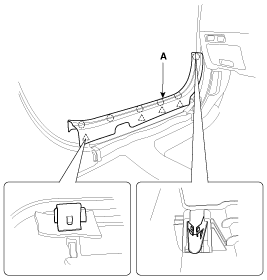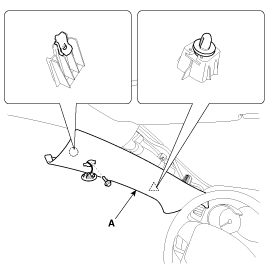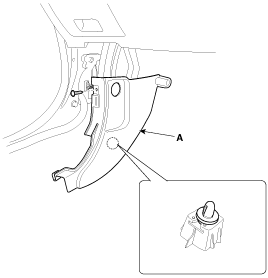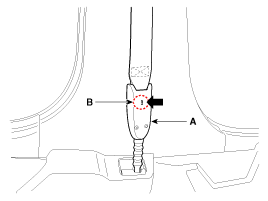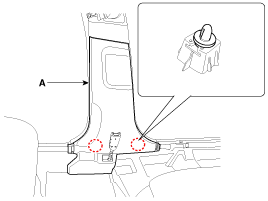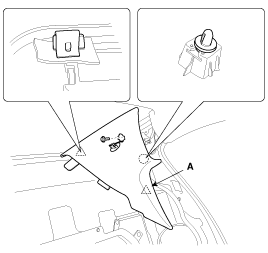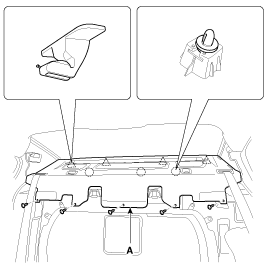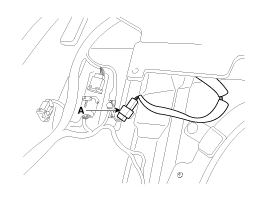Kia Cadenza: Interior / Interior Trim Repair procedures
Door Scuff Trim Replacement
•
Put on gloves to protect your hands.
•
When prying with a flat-tip screwdriver, wrap it with protective tape to prevent damage.
•
Take care not to bend or scratch the trim and panels.
1.
Using a screwdriver or remover, remove the front door scuff tirm (A).
[Front]
2.
Disconnect the connector (A).
3.
Remove the rear seat.
(Refer to the BD group - "Rear Seat")
4.
After loosening the mounting screws, then remove rear door scuff trim (A).
[Rear]
5.
Installation is the reverse of removal.
•
Replace any damage clips.
Front Pillar Trim Replacement
•
Put on gloves to protect your hands.
•
When prying with a flat-tip screwdriver, wrap it with protective tape to prevent damage.
•
Take care not to bend or scratch the trim and panels.
1.
After loosening the mounting bolt, then remove the front pillar trim (A).
2.
Installation is the reverse of removal.
•
Replace any damage clips.
Cowl Side Trim Replacement
•
Put on gloves to protect your hands.
•
When prying with a flat-tip screwdriver, wrap it with protective tape to prevent damage.
•
Take care not to bend or scratch the trim and panels.
1.
Remove the front door scuff trim.
2.
Remove the hood latch release handle.
(Refer to the BD group - "Hood")
3.
After loosening the mounting screw, then remove the cowl side trim (A).
4.
Installation is the reverse of removal.
Center Pillar Trim Replacement
•
Put on gloves to protect your hands.
•
When prying with a flat-tip screwdriver, wrap it with protective tape to prevent damage.
•
Take care not to bend or scratch the trim and panels.
1.
Remove the front door scuff trim and rear door scuff trim.
2.
The seat belt anchor pretensioner (A) be removed after pushing the lock pin (B) as arrow direction.
3.
Remove the center pillar lower trim (A).
4.
After loosening the mounting bolts, then remove the center pillar upper trim (A).
5.
Installation is the reverse of removal.
•
Replace any damaged clips.
Rear Pillar Trim Replacement
•
Put on gloves to protect your hands.
•
When prying with a flat-tip screwdriver, wrap it with protective tape to prevent damage.
•
Take care not to bend or scratch the trim and panels.
1.
After loosening the mounting bolt, then remove the rear pillar trim (A).
2.
Installation is the reverse of removal.
•
Replace any damaged clips.
Package Tray Trim Replacement
•
Put on gloves to protect your hands.
•
When prying with a flat-tip screwdriver, wrap it with protective tape to prevent damage.
•
Take care not to bend or scratch the trim and panels.
1.
Remove the rear seat assembly.
(Refer to the BD group - "Rear Seat")
2.
Remove the trunk trim.
(Refer to the BD group - "Trunk Trim")
3.
After loosening the mounting bolt, then remove the rear seat belt lower anchor (A).
Tightening torque:
39.2 ~ 53.9 N.m (4.0 ~ 5.5 kgf.m, 28.8 ~ 39.8 lb-ft)
4.
After loosening the mounting bolt, then remove the rear center seat belt lower anchor (A).
Tightening torque:
39.2 ~ 53.9 N.m (4.0 ~ 5.5 kgf.m, 28.8 ~ 39.8 lb-ft)
5.
After loosening the mounting bolt, then remove the rear pillar trim (A).
6.
Loosen the trunk inner mounting nuts.
7.
After loosening the mounting screws, then remove the package tray trim (A).
8.
Disconnect the connector (A).
9.
Installation is the reverse of removal.
•
Replace any damage clips.
•
Make sure the connector is connected properly.
Components
1. Front pillar trim2. Center pillar upper trim3. Center pillar lower trim4. Rear pillar trim5. Cowl side trim6. Front door scuff trim7. Rear door scuff trim8. Rear package tray tri ...
Replacement
•
Put on gloves to protect your hands.
•
When plying with a flat-tip screwd river, wrap it with protective tape to prevent damage.
...
Other information:
Description
When the vehicle is turning with respect to a vertical axis
the yaw rate sensor detects the yaw rate electroniclly by the vibration
change of plate fork inside the yaw rate sensor.
If yaw velocity reaches the specific velocity after it detects the vehicle''yawing, the ESP control ...
Never move the gear shift lever
from P (Park) to any other position
with the accelerator pedal
depressed.
Never move the gear shift lever into
P (Park) when the vehicle is in
motion.
Slow down before shifting to a
lower gear. Otherwise, the lower
gear may not be engaged.
...
 Interior Trim Components and Components Location
Interior Trim Components and Components Location Trunk Trim Repair procedures
Trunk Trim Repair procedures


